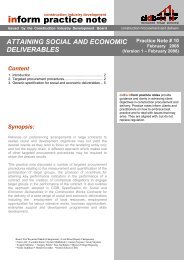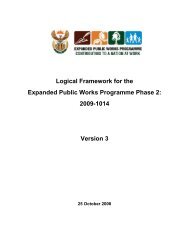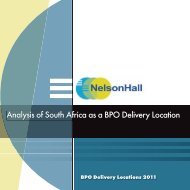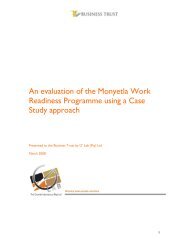Mitchell's Plain Nodal Economic Development Profile - Business Trust
Mitchell's Plain Nodal Economic Development Profile - Business Trust
Mitchell's Plain Nodal Economic Development Profile - Business Trust
- No tags were found...
You also want an ePaper? Increase the reach of your titles
YUMPU automatically turns print PDFs into web optimized ePapers that Google loves.
5.2 Commercial activityNotwithstanding household poverty in the area, the sheer number of people hascreated a market large enough to justify a number of commercial hubs. More than800 000 people live in Khayelitsha and Mitchell’s <strong>Plain</strong>, and their combinedpurchasing power is served through a number of large, formal commercialdevelopments. Although the relationship between commercial developments inKhayelitsha and Mitchell’s <strong>Plain</strong> is, to some extent, competitive, Mitchell’s <strong>Plain</strong> is apopular alternative shopping destination for Khayelitsha residents, so developmentsin one area affect the other.While there are administrative boundaries, it is clear that the economies of Mitchell’s<strong>Plain</strong> and Khayelitsha are bound together. The Khayelitsha/Mitchell’s <strong>Plain</strong> area istoo poor and too compact a space to justify more than a single high-ordercommercial node and a number of lower-order nodes.By far the most developed commercial node in Mitchell’s <strong>Plain</strong>/Khayelitsha is theMitchell’s <strong>Plain</strong> CBD. This is a URP anchor project and incorporates severaldevelopments. These include a 58 000 m 2 retail plaza, a smaller shopping centre inthe train station, an extension of the town centre, two major transport interchanges,and improvements to public spaces in the area. Public investment of R150 millionwas made over a period of four years, a large proportion of which was spent onpublic transport interchange infrastructure. A strong project team from the city led theMitchell’s <strong>Plain</strong> CBD process and took responsibility for implementation and decisionmaking at the project level. The team also helped to consolidate the highly fracturedbusiness community operating in the area and they facilitated agreement between24 taxi associations and five hawker associations. The project has created manytemporary and permanent employment opportunities for local residents.However, an ongoing challenge in Mitchell’s <strong>Plain</strong> is the high level of gang activity inthe area. Gangsters continue to threaten, intimidate and extract “tribute” frombusinesses. Gangs are also responsible for the drug trade in the area, as most gangleaders are drug lords.Another challenge faced by the area’s commercial sector is the continued leakage tocompeting shopping areas. The most popular alternative shopping areas forresidents of Khayelitsha/Mitchell’s <strong>Plain</strong> are the Cape Town CBD, Claremont,Bellville and Parow. This could be controlled by addressing crime and improvingpublic facilities.The informal sector is an important employer in Mitchell’s <strong>Plain</strong>, however, informaltraders face many constraints. Helping informal businesses to formalise would helpthem to increase turnover and employ more people. Recommendations forincreasing business viability focus on encouraging formalisation and increasing thelongevity of existing entrepreneurs.New developments should replicate models that have demonstrated success.Therefore, it is recommended that the Khayelitsha <strong>Trust</strong> model be replicated and11
















